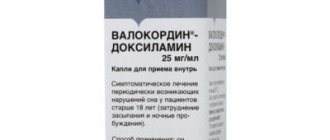Antiallergic drops Cetirizine do not have a strong odor and have a sweetish taste, so children do not refuse to take them. This is a very important characteristic of the drug, since sometimes it is difficult to get a child to take the medicine. With its help, you can quickly get rid of allergy symptoms such as watery eyes, itching, skin irritation, runny nose and other symptoms.
Composition and form of the drug
Cetirizine Sandoz drops look like a colorless solution. The drops have a specific, not pronounced odor and a pleasant sweet taste. The main component that gives the product medicinal properties is cetirizine dihydrochloride. The composition contains as auxiliary components:
- sodium acetate trihydrate;
- glycerol;
- benzoic acid;
- distilled water;
- propylene glycol.
Additional components in the composition are necessary to preserve the shelf life and give the drug a liquid form.
Cetirizine is produced in volumes of 10, 20 ml in dark glass bottles. To make it convenient to measure the drug, the bottle is equipped with a dropper stopper.
pharmachologic effect
Cetirizine is an antiallergic drug and is an H1 histamine receptor blocker. It has virtually no antiserotonin or anticholinergic effect. The sedative effect is also not pronounced. When used, it has an antiexudative, antipruritic effect, and reduces the severity of symptoms of allergic reactions.
The medication affects the first stage of allergic type reactions. It blocks the release of mediators that are involved in late allergic reactions. Reduces vascular permeability, the severity of tissue edema, and smooth muscle spasm. The drug is effective for skin manifestations of allergies, with the introduction of various allergens and histamine.
The drug is also effective for bronchial asthma, as it reduces the excessive activity of the bronchial tree, which is associated with the release of histamine in this disease. The effect of taking the drug can be noticed after 40 - 60. The effect of the drops can last up to 24 hours. Taking the drug as a course does not cause tolerance.
General information about the drug
Cetirizine drops for children are produced by the well-known company Ozone. The action of these drops is aimed at preventing allergic reactions in the child. The release form is very convenient for the growing body, as it has a minimum of adverse reactions.
The drug in drops is approved for use from 6 months of age.
The drug solution is a colorless transparent liquid, which sometimes has a brown tint. The solution has a characteristic odor.
Cetirizine blocks receptors that respond to histamine, an active component that is formed during allergic conditions. Thanks to its properties, the medicine quickly copes with allergy symptoms: itching, rhinitis, redness, swelling, erythema, etc.
Drops are especially effective at the initial stage of reactions, when the effect of the allergen has just begun. But even at a late stage of the disease, Cetirizine can be effective. Thanks to it, swelling decreases and smooth muscles relax.
Pharmacokinetics
After taking Cetirizine, its components are quickly and almost completely absorbed from the gastrointestinal tract. The maximum amount of active substances in the blood is observed on average after 40 minutes. The components bind to plasma proteins by 90–93%; they do not penetrate into cells, nor through the blood-brain barrier.
The drug undergoes breakdown in liver cells, its components are converted into inactive metabolites during reactions. When taking the medication for 1.5 weeks at a dose of 10 mg per day, no cumulative effect was observed. Cetirizine is excreted 75% from the body by the kidneys and urine.
Read more Montevisin eye drops - instructions for use and reviews
CETIRIZINE
Side effects
Evidence from Clinical Studies
Review
The results of clinical studies have demonstrated that the use of cetirizine in recommended doses leads to the development of minor adverse effects on the central nervous system (CNS), including drowsiness, fatigue, dizziness and headache. In some cases, paradoxical stimulation of the central nervous system has been reported.
Despite the fact that cetirizine is a selective blocker of peripheral H1 receptors and has virtually no anticholinergic effect, isolated cases of difficulty urinating, disturbances of accommodation and dry mouth have been reported.
Liver dysfunction has been reported, accompanied by increased levels of liver enzymes and bilirubin. In most cases, adverse events resolved after discontinuation of cetirizine.
List of unwanted side reactions
Data from double-blind, controlled clinical trials comparing cetirizine with placebo or other antihistamines given at recommended doses (10 mg once daily for cetirizine) in more than 3200 patients are available on which to conduct a reliable analysis safety data.
According to the results of the pooled analysis, in placebo-controlled studies with the use of cetirizine at a dose of 10 mg, the following adverse reactions were identified with an incidence of 1.0% or higher
| Adverse reactions (WHO terminology) | Cetirizine 10 mg (n = 3260) | Placebo (n = 3061) |
| General disorders and disorders at the injection site | ||
| Fatigue | 1,63% | 0,95% |
| Nervous system disorders | ||
| Dizziness | 1,10% | 0,98% |
| Headache | 7,42 % | 8,07% |
Gastrointestinal disorders _ | ||
| Abdominal pain | 0,98 % | 1,08% |
| Dry mouth | 2,09 % | 0,82% |
| Nausea | 1,07% | 1,14% |
| Mental disorder | ||
| Drowsiness | 9,63 % | 5,00 % |
| Respiratory, thoracic and mediastinal disorders | ||
| Pharyngitis | 1,29% | 1,34% |
Although the incidence of somnolence in the cetirizine group was higher than that in the placebo group, most cases were mild or moderate in severity. When objectively assessed in other studies, it was confirmed that the use of cetirizine at the recommended daily dose in healthy young volunteers does not affect their daily activities.
Children
In placebo-controlled studies, the following adverse reactions were observed with an incidence of 1% or higher in children aged 6 months to 12 years:
| WHO terminology | Cetirizine ( n =1656) | Placebo ( n =1294) |
| Gastrointestinal disorders | ||
| Diarrhea | 1,0% | 0,6% |
| Mental disorder | ||
| Drowsiness | 1,8% | 1,4% |
| Disorders of the respiratory system, chest organs and mediastinum | ||
| Rhinitis | 1,4% | 1,1% |
| General disorders and disorders at the injection site | ||
| Fatigue | 1,0% | 0,3% |
Post-registration experience
In addition to the adverse events identified during clinical trials and described above, the following adverse reactions were observed during post-registration use of the drug.
Adverse events are presented below by MedDRA organ system class and incidence, based on data from post-marketing use of the drug. The incidence of adverse events was determined as follows: very often (≥1/10); often (≥1/100, <1/10); uncommon (≥1/1000, <1/100); rare (≥1/10000, <1/1000); very rare (<1/10000), frequency unknown (due to insufficient data).
From the blood and lymphatic system
: very rarely - thrombocytopenia.
From the immune system
: rarely - hypersensitivity reactions; very rarely - anaphylactic shock.
Metabolic and eating disorders
: frequency unknown - increased appetite.
Mental disorders
: infrequently - excitement; rarely - aggression, confusion, depression, hallucinations, sleep disturbance; very rarely - tic; frequency unknown - suicidal ideation.
From the nervous system
: infrequently - paresthesia; rarely - convulsions; very rarely - taste perversion, dyskinesia, dystonia, fainting, tremor; frequency unknown - memory impairment, including amnesia.
From the side of the organ of vision
: very rarely - disturbance of accommodation, blurred vision, nystagmus.
From the hearing organs
: frequency unknown - vertigo.
From the digestive system
: uncommon - diarrhea.
From the cardiovascular system
: rarely - tachycardia.
Hepatobiliary disorders
: rarely - changes in liver function tests (increased activity of transaminases, alkaline phosphatase, gamma-glutamyltransferase and bilirubin).
From the skin
: uncommon - rash, itching; rarely - urticaria; very rarely - angioedema, persistent drug erythema.
From the urinary system
: very rarely - dysuria, enuresis; frequency unknown - urinary retention.
General disorders
: infrequently - asthenia, malaise; rarely - peripheral edema.
Research
: rarely - weight gain.
Adverse Reaction Alert
A system for reporting suspected adverse reactions after registration of a medicinal product is of great importance.
This allows continuous monitoring of the benefit/risk ratio of the drug.
Indications for use
Drops are used to eliminate allergy symptoms. Moreover, they can be used both for already developed allergies and to prevent its occurrence. Indications:
- allergic rhinitis, conjunctivitis, which is associated with flowering plants or other allergens;
- hives;
- dermatitis accompanied by itching;
- allergic reaction to insect bites;
- seasonal fever;
Also, the drug is often prescribed by pediatricians to children, after the administration of vaccines or before starting antibiotic therapy, to prevent allergic manifestations.
Instructions for use
Before use, the product can be diluted with plain water (about 1 teaspoon). Dosage of the drug for adults, including children over 12 years old – 20 drops 1 time per day. They can be taken at any time of the day, but it is advisable to take them in the evening. Children from 1 to 6 years old – 5 drops 2 times a day. Older children are prescribed 10 drops 2 times a day, or, like adults, 20 drops 1 time a day.
In case of renal failure, it is necessary to adjust the dose and reduce it by 2 times. Only a doctor can determine the exact duration of treatment. On average it is 3 – 6 weeks. In children from 1 year to 4 weeks. For an insect bite, the drug is most often taken for 1 to 2 days.
Cetirizine drops for ext. 10mg/ml 20ml fl ozone
Pharmacological group:
Antiallergic drug - H1-histamine receptor blocker
Pharmacodynamics:
Cetirizine is the active substance of the drug, is a metabolite of hydroxyzine, belongs to the group of competitive histamine antagonists and blocks H1-histamine receptors. In addition to the antihistamine effect, cetirizine prevents the development and alleviates the course of allergic reactions: at a dose of 10 mg once or twice a day, it inhibits the late phase of eosinophil aggregation in the skin and conjunctiva of patients prone to atopy. Clinical efficacy and safety Studies in healthy volunteers have shown that cetirizine at doses of 5 or 10 mg significantly inhibits the rash and redness response to high concentrations of histamine in the skin, but a correlation with efficacy has not been established. A 6-week placebo-controlled study involving 186 patients with allergic rhinitis and concomitant mild to moderate asthma showed that cetirizine 10 mg once daily reduced rhinitis symptoms and did not affect pulmonary function. The results of this study confirm the safety of cetirizine in patients suffering from allergies and mild to moderate bronchial asthma. A placebo-controlled study showed that taking cetirizine at a dose of 60 mg per day for 7 days did not cause a clinically significant prolongation of the QT interval. Taking cetirizine at the recommended dose showed an improvement in the quality of life of patients with year-round and seasonal allergic rhinitis. Children In a 35-day study involving patients aged 5-12 years, there was no evidence of resistance to the antihistamine effect of cetirizine. The normal skin reaction to histamine was restored within three days after discontinuation of the drug with repeated use. A 7-day placebo-controlled study of cetirizine syrup in 42 patients aged 6 to 11 months demonstrated its safety. Cetirizine was administered at a dose of 0.25 mg/kg twice daily, which corresponds to approximately 4.5 mg per day (dose range was 3.4 to 6.2 mg per day). Use in children from 6 to 12 months is possible only as prescribed by a doctor and under strict medical supervision.
Reviews about the use of drops in children
Maria, 30 years old
My son is 7 years old, and this year he developed an allergy to flowering trees, although this has never happened before. It manifested itself with a runny nose, sneezing and red eyes. I took him to the pediatrician, and he prescribed Cetirizine for him to drink. I gave him drops 2 times a day. I noticed the effect on the second day - the runny nose began to decrease, and my eyes stopped watering. There were no side effects, and since the drug helped us, next year, if allergies appear again, I will definitely buy it.
Oksana, 27 years old
This is not the first time I have bought Cetirizine for my nephew. He is allergic to ragweed, and although it is rarely found in our area, he still manages to find it somewhere. That's why the drops are always in our first aid kit. They are relatively inexpensive, I buy them for 215 rubles per 20 ml. And he usually has enough for the season. The main thing is that they help quickly and have a sweet taste.
Ekaterina, 26 years old
My daughter broke out after she overate tangerines for the New Year. The rashes were almost all over the body and were a little itchy. Since I have three children, my medicine cabinet is always full of medicines for everything. For allergies, I always give them Cetirizine. I personally like the drug - it quickly relieves symptoms, is relatively inexpensive, can be stored for a long time after opening, and the main thing is that it has never caused any side effects. In addition, children do not need to be persuaded to drink it, because it is slightly sweet and does not have a sharp, unpleasant odor.
Price
The price of the drug depends on the form. In general, it ranges from 50 to 150 rubles, which allows it to be extremely cheap among antihistamines. The low price is due to the well-developed synthesis technique and the availability of precursors. The product has been studied by doctors at the moment and has no strong side effects, which makes it an excellent choice for children aged one year and older.
The low price of the drug does not exempt you from such a thing as instructions, therefore, before giving the drug to your child, be sure to read it.
Before your appointment, consultation with your local or private pediatrician is required, since some symptoms mistakenly taken for an allergy may have a completely different cause. Self-medication can lead to disastrous results and only harm the child, instead of the expected improvement in the situation.
Contraindications
The drug is prohibited for children under 1 year of age, as well as:
- pregnant women;
- breastfeeding;
- having severe kidney disease;
- people who have hypersensitivity to the components of the drops.
Read more Rinofluimucil - how to use nasal drops for children
Caution is necessary when prescribing the drug to people with chronic pyelonephritis and the elderly. For them, dose adjustments should be made during treatment.
Side effects
An allergy medication may itself cause allergic reactions if its components are intolerant. They can manifest themselves in the form of urticaria, angioedema, and skin itching. If these symptoms were the reason for taking the drug, their severity may increase. Other side effects:
- dry mouth;
- nausea;
- diarrhea;
- headache;
- dizziness;
- drowsiness;
- excitation;
- fatigue.
These symptoms appear extremely rarely.
Contraindications and possible side effects
The medicine is contraindicated for use in the following categories of children:
- If the child has an intolerance to some of the components of the drug: cetirizine, hydroxyzine, any piperazine derivatives and other substances.
- In the presence of end-stage renal failure.
- The child's age is up to 6 months, since there are no research data for this age period of children.
For adults, the drug is contraindicated during pregnancy.
Adverse reactions occur extremely rarely; in general, children tolerate Cetirezin drops well. The most common reactions to the drug are the following:
- Headache.
- Drowsiness.
- The appearance of dryness in the oral cavity.
- Pain in the abdomen.
- Diarrhea.
- Nervous disorders.
- Rhinitis, etc.
If these side effects are present, the use of Cetirezin drops should be stopped and the child’s condition should be reported to the doctor.
Similar symptoms can occur with an overdose of the drug. In this case, you need to show the child to the doctor as soon as possible. The main actions are to take sorbents, lavage the stomach and provide rest to the patient.
Overdose
If you regularly exceed the recommended dose, or use Cetirizine for longer than prescribed or indicated in the instructions, symptoms of overdose may appear:
- severe fatigue, fatigue;
- drowsiness;
- urinary retention;
- excessive irritability;
- lethargy;
- headache;
- tachycardia.
These symptoms may develop when taking 50 mg or more per day. There is no antidote for Cetirizine. When drinking the drug, the stomach is washed and sorbents are prescribed. Depending on the symptoms, symptomatic treatment is carried out.
Additional Information
It is not recommended to use Cetirizine together with medications that depress the central nervous system. When treating with drops, it is not advisable to take ethanol (alcoholic drinks), since their interaction may cause side effects or reduce the therapeutic effect of the drug.
There are no drugs that are absolutely contraindicated during treatment with Cetirizine. An antiallergic drug can affect the speed of psychomotor reactions and cause drowsiness. Considering this fact, during treatment it is undesirable to drive vehicles or engage in work that requires concentration, attention and a quick psychomotor reaction.
special instructions
While taking the drug, it is necessary to limit activities that require increased concentration and reaction speed.
For children under 1 year of age, special caution should be exercised in certain situations, due to the fact that the components of Cetirizine have a depressant effect on the central nervous system:
- If the mother took drugs or smoked during pregnancy.
- If a woman gave birth to a child when she was very young, that is, before the age of 19.
- If the baby stays in a room where adults smoke excessively.
- If the child sleeps face down.
- Premature or low birth weight babies.
- If additional CNS depressants have been prescribed.
Analogs
Drugs with similar effects are:
- Loratadine.
- Cetrin.
- Zodak.
- Zyrtec.
- Claritidine.
- Parlazin.
Read more Instructions for using Emoxy Optic eye drops
Antiallergic drugs with other active ingredients include: Fenistil, Claritin, Erius, Fenkarol, Suprastinex.








